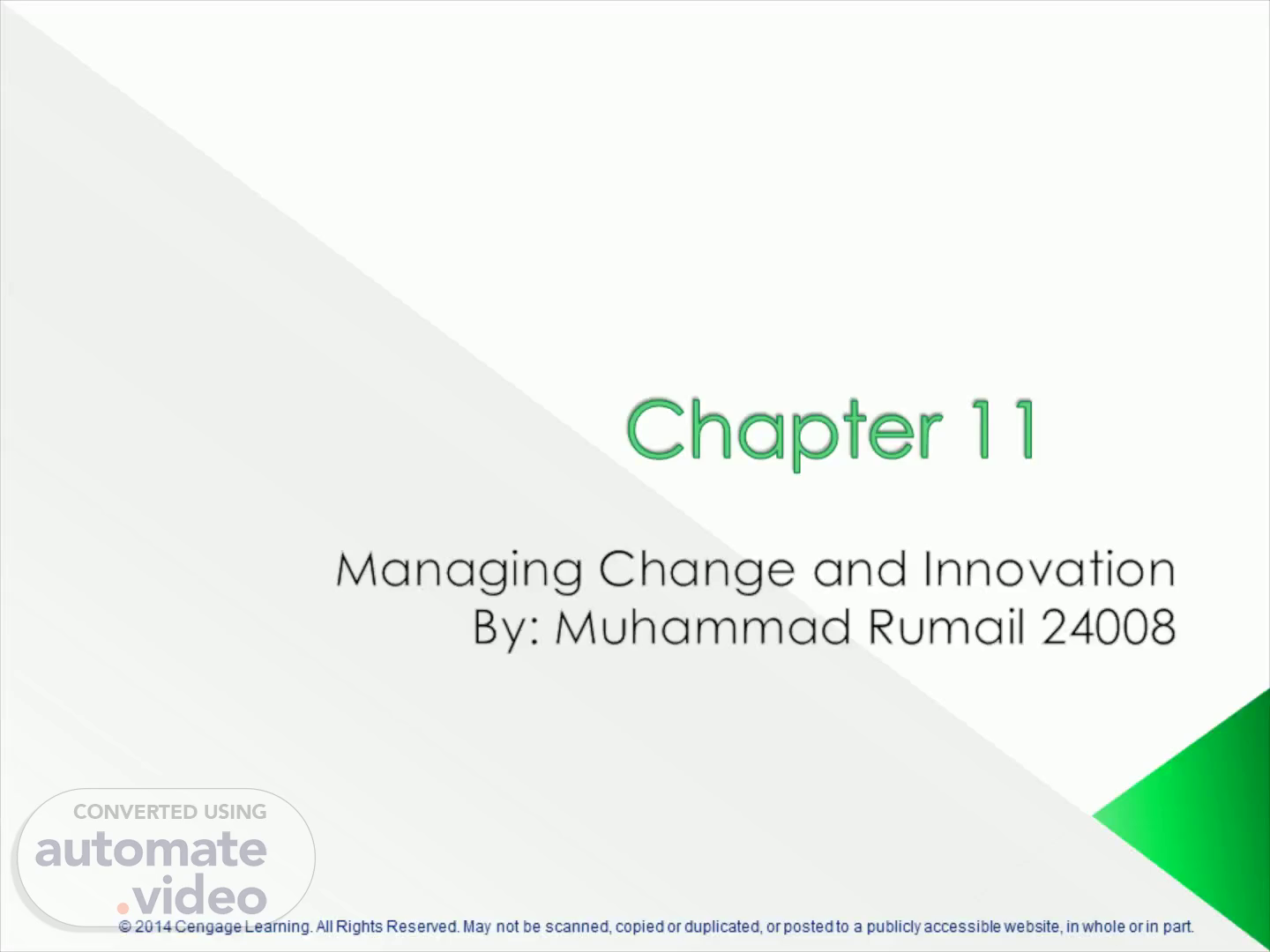Scene 1 (0s)
Chapter 11. Managing Change and Innovation By: Muhammad Rumail 24008.
Scene 2 (7s)
Instructions. These slides have been voiced over by me, Muhammad Rumail . In order to listen to the voice over attached, one must click on the “speaker icon” located at the bottom right corner of each slide. After that a horizontal bar with a “play” button will appear, click the “play” button. The voice notes contain verbal presentation. Thank you.
Scene 3 (26s)
Introduction. If organizations don’t successfully change and innovate, they die.
Scene 4 (34s)
Changing People and Culture. Changes in how employees think Changes in mind-set People change = Training and development Culture change = Organizational development Large culture change is not easy.
Scene 5 (2m 36s)
Major Difference Between People Change and Culture Change.
Scene 6 (4m 47s)
Training and Development. Training – Frequently used approach to changing people’s mind-sets Training and development is emphasized for managers Behavior and attitudes will influence people and lead to culture change Through these training programs, companies provide their employees with appropriate soft skills and hard skills that enable them to work more efficiently.
Scene 7 (6m 51s)
Organizational Development. Planned, systematic process of change using behavioral science Addresses three types of problems: Mergers and acquisitions Organizational decline and revitalization Conflict management.
Scene 8 (11m 51s)
OD Activities. Team-building activities Survey-feedback activities Large-group interventions OD Steps: Unfreezing Changing Refreezing.
Scene 9 (16m 51s)
9. Unfreezing The problem is made elaborate The organization is made ready for the upcoming change Changing The much speculated change is carried out Refreezing The positive changes have been made and they are now being reinforced.
Scene 10 (18m 6s)
Stages of OD. 10.
Scene 11 (19m 0s)
11.6 - OD Approaches to Culture Change. 11. Focus for action: Information Source: Distribution: Time frame: Learning: Change process: Traditional Organization Development Model Specific problem or group Organization Limited Gradual Individual, small group Incremental change Large-Group Intervention Model Entire system Organization and environment Widely shared Fast Whole organization Rapid transformation SOURCE:Adapted from Barbara Benedict Bunker and BillieT. Aban, "Conclusion:VVhat Makes Large Group Interventions Effective?"Journal ofApplied Behavioral Science 28, no. 4 (December 1992): 579—591..
Scene 12 (19m 20s)
Implementing Change. Need for change Disparity between existing and desired performance levels Understand the resistance to change Self-interest Lack of understanding and trust Uncertainty Different assessments and goals.
Scene 13 (21m 18s)
11.7 - Force-Field Analysis. Change is a result of the competition between driving and restraining forces Driving forces – problems or opportunities that provide motivation for change Restraining forces – barriers to change.
Scene 14 (23m 21s)
What does the Force field analysis do?. In force field analysis, first the driving forces and the restraining forces are recognized. Then the restraining forces are eliminated and the driving forces are further strengthened This will help the driving forces dominate restraining forces in a given change and thus it will help in the implementation of the change.
Scene 15 (25m 23s)
11.7 – Using Force-Field Analysis to Change from Traditional to Just-in-Time Inventory System.
Scene 16 (25m 41s)
11.8 - Tactics for Overcoming Resistance to Change.
